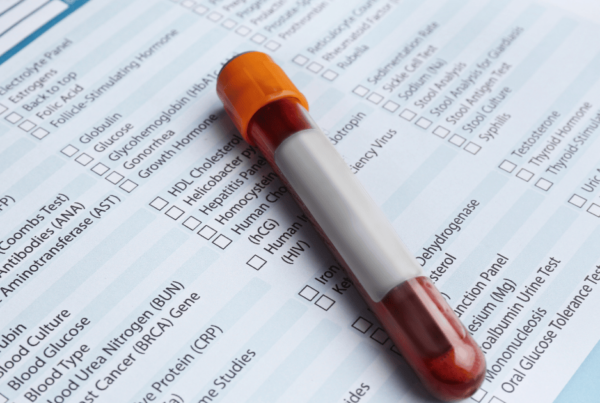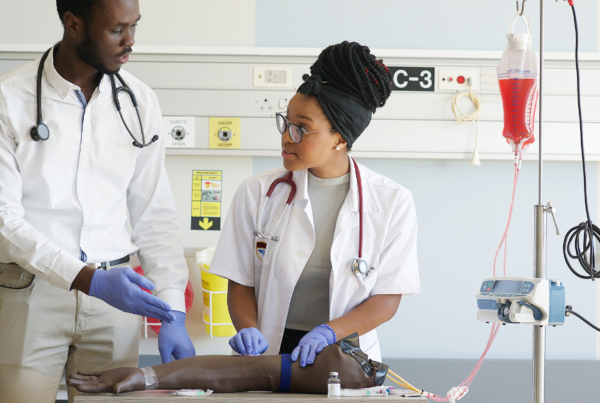In the medical field, it’s common to hear the terms venipuncture and phlebotomy used interchangeably, but they have distinct meanings. For healthcare professionals and students entering the medical field, it’s essential to understand the differences between venipuncture vs phlebotomy to ensure precise communication and execution of these procedures. Whether you’re a medical assistant, nurse, or phlebotomist, knowing when to use each term and how to perform the associated tasks is critical to patient care and professional competency.
In this article, we will explore the differences between venipuncture and phlebotomy, discuss their purposes in medical settings, outline the role of medical assistants, and explain the training involved in performing these procedures.
| Key Takeaways: |
| Venipuncture refers to accessing a vein with a needle, while phlebotomy is specifically the act of drawing blood. |
| Medical assistants often perform phlebotomy for diagnostic testing. |
| Phlebotomy is essential for diagnosing and monitoring a wide range of health conditions. |
| Proper venipuncture and phlebotomy techniques ensure the accuracy of test results. |
What Is Venipuncture?
Venipuncture is the process of puncturing a vein with a needle, typically to access blood vessels for various medical purposes. Venipuncture can be performed for multiple reasons, including:
- Drawing blood for laboratory tests
- Administering intravenous (IV) medications
- Collecting blood for donations
The primary focus of venipuncture is to gain access to a vein, making it a procedure that may be performed by several healthcare professionals, including medical assistants, nurses, and phlebotomists. Venipuncture is an essential skill that medical assistants often need to master, especially when they are responsible for drawing blood or preparing patients for more complex medical procedures.
What Is Phlebotomy?
Phlebotomy is a more specialized term that refers specifically to the process of drawing blood for laboratory testing, medical examination, or donation. In contrast to venipuncture, phlebotomy is a more focused procedure, aimed specifically at collecting blood samples for diagnostic or therapeutic purposes. Phlebotomists are trained to ensure that blood samples are collected safely, efficiently, and without causing discomfort to the patient.
Phlebotomy plays a vital role in healthcare as it allows doctors to diagnose and monitor a wide range of health conditions by analyzing blood samples. From routine blood tests to complex diagnostic procedures, phlebotomy is central to modern medical diagnostics.
Key Differences Between Venipuncture and Phlebotomy
The primary difference between venipuncture and phlebotomy lies in their purpose and scope. Venipuncture is the method of accessing a vein, while phlebotomy is the act of drawing blood for testing or donation.
- Venipuncture: A broader term referring to any procedure where a vein is accessed with a needle.
- Phlebotomy: A specific type of venipuncture performed for the purpose of drawing blood for analysis or donation.
While venipuncture can serve various medical functions, phlebotomy is limited to blood collection. However, both venipuncture and phlebotomy require proper training, attention to safety protocols, and precision to ensure patient comfort and accurate results.
Role of Medical Assistants in Venipuncture and Phlebotomy
Medical assistants are integral members of the healthcare team and are often trained in both venipuncture and phlebotomy. They may perform venipuncture in various clinical settings, from private practices to hospitals. However, their ability to perform these tasks depends on state regulations and the scope of their responsibilities within the healthcare facility.
Responsibilities of Medical Assistants
Medical assistants perform a wide range of tasks, both administrative and clinical. Their duties may include:
- Managing schedules and triaging phone calls
- Updating medical records and assisting with billing
- Obtaining vital signs and updating patient histories
- Performing diagnostic tests and collecting biological samples
- Assisting in-office procedures and sterilizing instruments
Phlebotomy is an essential skill for medical assistants, as they often collect blood samples to help physicians diagnose and monitor health conditions. Mastery of venipuncture is crucial for medical assistants, as it directly impacts their ability to perform phlebotomy accurately and efficiently.
Phlebotomy Equipment Used by Medical Assistants
To perform phlebotomy, medical assistants need a variety of tools to ensure a safe and effective procedure. Common equipment includes:
- Gloves: To prevent contamination and protect both the patient and the medical assistant.
- Alcohol Pads: Used to clean the skin before inserting the needle, reducing the risk of infection.
- Tourniquet: Applied to the patient’s arm to make veins more visible and accessible.
- Needles: Varying in size and gauge depending on the patient’s vein and procedure requirements.
- Collection Tubes: Vacuum-sealed tubes designed to collect and store blood samples for testing.
- Gauze and Bandages: Applied after blood is drawn to prevent bleeding and protect the site from infection.
Phlebotomy Procedure: A Step-by-Step Guide
Phlebotomy is a detailed process that requires precision and adherence to safety protocols. Medical assistants performing phlebotomy must follow these key steps:
- Review the Doctor’s Order: Confirm the tests required and the patient’s identity.
- Screen the Patient: Ensure the patient follows any preparation instructions, such as fasting, and check for allergies.
- Obtain Consent: Patients must give informed consent for the procedure.
- Select the Right Equipment: Choose appropriate needles and tubes based on the patient’s vein size and condition.
- Prepare the Supplies: Organize all the necessary tools before beginning the procedure.
- Position the Patient: Ensure the patient is comfortable and positioned safely.
- Perform the Venipuncture: Insert the needle, collect the blood, and follow all safety protocols.
- Educate the Patient: Provide post-procedure instructions and contact information for follow-up questions.
- Label the Samples: Accurately label each blood sample with the patient’s information.
- Process the Sample: Store or process the blood samples as needed, depending on the test requirements.
Venipuncture for IV Administration and Blood Donations
Venipuncture is not limited to phlebotomy. It is also applied in various medical contexts, such as:
- Intravenous (IV) Drug Administration: Nurses insert an IV catheter into a vein for medication delivery.
- Blood Donations: Phlebotomists may perform venipuncture to collect blood for donation, which requires proper certification.
These procedures require specialized training and, in some cases, licensure. While medical assistants can perform venipuncture for blood collection, more complex procedures, such as IV administration, are typically reserved for nurses and other licensed healthcare providers.
Why Venipuncture and Phlebotomy Are Critical in Healthcare
Both venipuncture and phlebotomy are essential to healthcare because they provide doctors with critical information about a patient’s health. Blood tests can detect a wide range of conditions, including:
- Anemia
- Diabetes
- Cancer
- Thyroid disorders
- Electrolyte imbalances
- Infections
- Liver and kidney diseases
Accurate venipuncture and phlebotomy procedures are essential for obtaining reliable test results. Even minor errors, such as improper labeling or incorrect tube selection, can lead to inaccurate diagnoses or the need for repeat tests, which can inconvenience patients and delay treatment.
How Medical Assistants Learn Phlebotomy
Medical assistants typically learn phlebotomy as part of their vocational training programs. During their education, they practice venipuncture and phlebotomy in controlled settings, honing their skills on classmates and simulated patients. Externships provide hands-on experience in real medical environments under the supervision of licensed professionals.
Career Opportunities for Medical Assistants with Phlebotomy Skills
As demand for skilled healthcare professionals increases, medical assistants with phlebotomy expertise are in high demand. Phlebotomy skills enhance a medical assistant’s versatility, making them valuable assets in various settings, including:
- Private Practices: Medical assistants in doctor’s offices often perform blood draws as part of routine care.
- Hospitals: Medical assistants working in hospitals may serve both inpatients and outpatients, providing diverse experiences.
- Clinics: Clinics rely on medical assistants for phlebotomy due to their broad skill set.
- Insurance Companies: Some insurers employ medical assistants to perform blood draws for pre-coverage exams.
FAQs:
What’s the primary difference between venipuncture and phlebotomy?
Venipuncture is the technique of puncturing a vein, while phlebotomy specifically refers to drawing blood for testing or transfusion.
Can medical assistants perform venipuncture?
Yes, medical assistants can perform venipuncture, but typically only for the purpose of phlebotomy.
What equipment is used in phlebotomy?
Phlebotomy requires gloves, alcohol pads, a tourniquet, needles, collection tubes, gauze, and bandages.
Where can medical assistants work as phlebotomists?
Medical assistants can work in private practices, hospitals, clinics, and even for insurance companies, performing phlebotomy as part of their duties.
Why is phlebotomy important in healthcare?
Phlebotomy is critical for diagnosing illnesses, monitoring treatment, and providing vital health data to physicians.
Conclusion
Understanding the distinction between venipuncture and phlebotomy is crucial for aspiring medical assistants and healthcare professionals. While venipuncture refers to the broader practice of accessing veins for various purposes, phlebotomy is specifically concerned with drawing blood for diagnostic or therapeutic reasons. Mastery of both procedures is essential for medical assistants, making them indispensable members of the healthcare team.
For those interested in pursuing a career in healthcare, mastering venipuncture and phlebotomy opens doors to a variety of career paths. Whether in private practices, hospitals, or clinics, the ability to perform these procedures efficiently and safely is a valuable skill that enhances patient care and medical outcomes.
Phlebotomy Now School in Texas offers comprehensive training programs designed to equip students with the knowledge and hands-on experience necessary to excel in the field of medical assisting. With a focus on both clinical and administrative skills, our program prepares you for a rewarding career in healthcare.
Ready to Learn the Difference Between Venipuncture vs Phlebotomy?
At Phlebotomy Now School in Texas, we’ll teach you the essential skills to excel in healthcare, including venipuncture vs phlebotomy techniques.
Get hands-on training and start your career as a medical assistant today—contact us to learn more!


